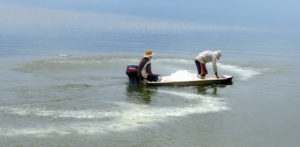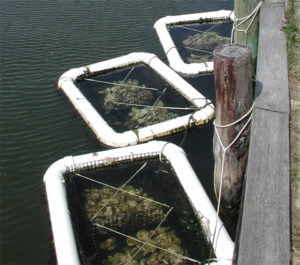
Biofloc reduces feed, filtration costs in recirculating shrimp nursery system
Trials with recirculating shrimp nursery systems in India supported the use of biofloc. To control ammonia is a way to reduce filtration costs.
In the authors’ recent study, sea cucumbers were added directly to abalone cages with no modifications of the culture equipment to form a simple, low-cost IMTA production system.

Trials with recirculating shrimp nursery systems in India supported the use of biofloc. To control ammonia is a way to reduce filtration costs.

U.S. institutions are collaborating to evaluate low-energy recirculating aquaculture system designs to produce marine finfish in a low-salinity environment.

In calculating chemical treatments to apply to ponds, one must adjust for the percentage of the active ingredients in products. Adjustments for both active ingredient content and specific gravity must be made for liquid products.

Ponds constructed on sandy or permeable soils are most likely to have high seepage rates. Ponds built in any soil can seep if improperlty constructed.

One of the chief limitations for the tuna aquaculture industry is its primary dependence on diminishing wild fish to stock marine cages.

Speece cones are capable of providing high concentrations of dissolved oxygen or ozone for water used in aquatic systems. High pressure within the cone systems diffuses the oxygen or ozone into the water as it flows downward through the inverted cone shape of the units.

Through the integration of aquaculture and the involvement of residents, the U.S. state of Delaware is working to restore its native oyster populations.

As an alternative to pond production, U.S. scientists have developed bio-secure greenhouse-enclosed raceways for intensive shrimp production with limited water exchange.

Hatcheries produce Korean rockfish seedlings in indoor tanks for sorting and grading. The fish grow well at relatively low water temperatures in net cages.

In a study comparing U-shaped plastic culture tanks to concrete raceways in a 31-week grow-out of trout fingerlings showed the plastic tanks offered lower costs, easy modification, transportability and reduced labor for cleaning.

Authors found the biofilter unit portion of the Intensive Bioproduction Korean system originally developed for nitrification can remove suspended solids.

The Hydraulically Integrated Serial Turbidostat Algal Reactor (HISTAR) developed at Louisiana State University superimposes contaminant control techniques on a continuous algal production system.

Aquaculture ponds typically have ideal conditions for the growth of various species of phytoplankton. Green algae are considered most desirable in freshwater ponds.

Ponds should be fertilized a few days after chlorine application to encourage the regrowth of natural food organisms before introducing postlarvae.

The authors have begun a project to further investigate stock enhancement as a tool for rebuilding depleted lingcod stocks in Puget Sound in Washington, USA.